
How to Use 1.8" 128x160 TFT 65K color screen: Examples, Pinouts, and Specs
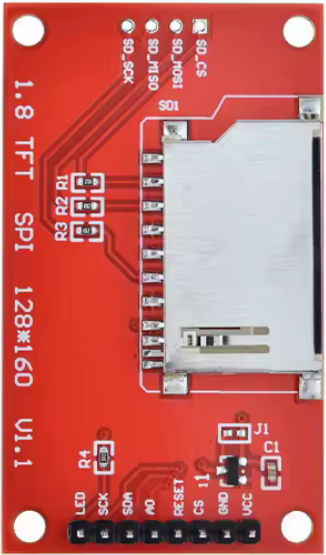
 Design with 1.8" 128x160 TFT 65K color screen in Cirkit Designer
Design with 1.8" 128x160 TFT 65K color screen in Cirkit Designer1.8" 128x160 TFT 65K Color Screen Documentation
Introduction
The 1.8" 128x160 TFT 65K Color Screen (Manufacturer Part ID: MSP1803, powered by the ST7735S driver) is a compact, high-resolution display module designed for embedded systems and portable devices. With its 128x160 pixel resolution and support for 65,000 colors, this display is ideal for applications requiring vibrant visuals in a small form factor.
This module is widely used in projects such as:
- Portable devices (e.g., handheld consoles, smart gadgets)
- Embedded systems (e.g., IoT devices, data loggers)
- Graphical user interfaces (GUIs) for microcontroller-based projects
- Educational and prototyping purposes with platforms like Arduino, Raspberry Pi, and ESP32
Its small size, low power consumption, and SPI interface make it a popular choice for hobbyists and professionals alike.
Technical Specifications
The following table outlines the key technical details of the 1.8" 128x160 TFT 65K Color Screen:
| Parameter | Specification |
|---|---|
| Display Type | TFT LCD |
| Resolution | 128x160 pixels |
| Color Depth | 65,536 colors (16-bit RGB565 format) |
| Driver IC | ST7735S |
| Interface | SPI (Serial Peripheral Interface) |
| Operating Voltage | 3.3V (logic level) |
| Backlight Voltage | 3.0V to 3.3V |
| Current Consumption | ~50mA (with backlight on) |
| Screen Size | 1.8 inches (diagonal) |
| Viewing Angle | ~160° |
| Operating Temperature | -20°C to 70°C |
| Dimensions | 35mm x 52mm x 6mm |
Pin Configuration
The module has an 8-pin interface. The table below describes each pin:
| Pin | Name | Description |
|---|---|---|
| 1 | GND | Ground connection |
| 2 | VCC | Power supply (3.3V recommended) |
| 3 | SCL (CLK) | SPI clock signal |
| 4 | SDA (MOSI) | SPI data input (Master Out Slave In) |
| 5 | RES (RST) | Reset pin (active low) |
| 6 | DC (A0) | Data/Command control pin (High = Data, Low = Command) |
| 7 | CS | Chip Select (active low) |
| 8 | BLK | Backlight control (connect to 3.3V for always-on or PWM for brightness control) |
Usage Instructions
Connecting the Display to an Arduino UNO
The 1.8" 128x160 TFT can be easily interfaced with an Arduino UNO using the SPI protocol. Below is the recommended wiring:
| TFT Pin | Arduino UNO Pin | Description |
|---|---|---|
| GND | GND | Ground connection |
| VCC | 3.3V | Power supply |
| SCL (CLK) | D13 | SPI clock |
| SDA (MOSI) | D11 | SPI data |
| RES (RST) | D8 | Reset pin |
| DC (A0) | D9 | Data/Command control |
| CS | D10 | Chip Select |
| BLK | 3.3V or PWM pin | Backlight control |
Arduino Code Example
Below is an example Arduino sketch to initialize and display basic graphics on the screen using the Adafruit ST7735 library:
#include <Adafruit_GFX.h> // Core graphics library
#include <Adafruit_ST7735.h> // ST7735 driver library
#include <SPI.h> // SPI library
// Define TFT pins
#define TFT_CS 10 // Chip Select pin
#define TFT_RST 8 // Reset pin
#define TFT_DC 9 // Data/Command pin
// Initialize the display object
Adafruit_ST7735 tft = Adafruit_ST7735(TFT_CS, TFT_DC, TFT_RST);
void setup() {
// Initialize serial communication for debugging
Serial.begin(9600);
Serial.println("TFT Display Test");
// Initialize the TFT display
tft.initR(INITR_BLACKTAB); // Initialize with ST7735S driver
tft.setRotation(1); // Set screen rotation (0-3)
tft.fillScreen(ST77XX_BLACK); // Clear screen with black color
// Display a message
tft.setTextColor(ST77XX_WHITE); // Set text color to white
tft.setTextSize(2); // Set text size
tft.setCursor(10, 10); // Set cursor position
tft.println("Hello, World!"); // Print text
}
void loop() {
// Draw a red rectangle
tft.fillRect(20, 40, 50, 30, ST77XX_RED);
// Draw a green circle
tft.fillCircle(80, 80, 20, ST77XX_GREEN);
// Add a delay
delay(2000);
}
Important Considerations
- Voltage Levels: The display operates at 3.3V logic levels. If using a 5V microcontroller (e.g., Arduino UNO), use level shifters or resistors to step down the signals.
- Backlight Control: The backlight pin (BLK) can be connected to 3.3V for constant illumination or to a PWM pin for brightness control.
- Library Compatibility: Ensure you have the latest versions of the Adafruit GFX and Adafruit ST7735 libraries installed in your Arduino IDE.
Troubleshooting and FAQs
Common Issues
No Display Output
- Cause: Incorrect wiring or loose connections.
- Solution: Double-check all connections and ensure proper pin mapping.
Flickering or Distorted Graphics
- Cause: Insufficient power supply or noisy signals.
- Solution: Use a stable 3.3V power source and keep SPI wires short.
Backlight Not Turning On
- Cause: BLK pin not connected or insufficient voltage.
- Solution: Connect BLK to 3.3V or a PWM pin for brightness control.
Screen Stuck on White
- Cause: Incorrect initialization or faulty reset pin.
- Solution: Verify the reset pin connection and ensure proper initialization in the code.
FAQs
Can I use this display with a 5V microcontroller?
- Yes, but you must use level shifters or resistors to step down the 5V signals to 3.3V.
What is the maximum SPI clock speed supported?
- The ST7735S driver supports SPI clock speeds up to 15 MHz.
Can I control the backlight brightness?
- Yes, connect the BLK pin to a PWM-capable pin on your microcontroller and adjust the duty cycle.
Is this display compatible with Raspberry Pi?
- Yes, it can be used with Raspberry Pi via SPI, but you may need to configure the SPI interface and use appropriate libraries.
Conclusion
The 1.8" 128x160 TFT 65K Color Screen is a versatile and compact display module suitable for a wide range of applications. Its ease of use, vibrant color output, and compatibility with popular microcontroller platforms make it an excellent choice for both beginners and advanced users. By following the guidelines and examples provided in this documentation, you can quickly integrate this display into your projects and bring your ideas to life.
Explore Projects Built with 1.8" 128x160 TFT 65K color screen
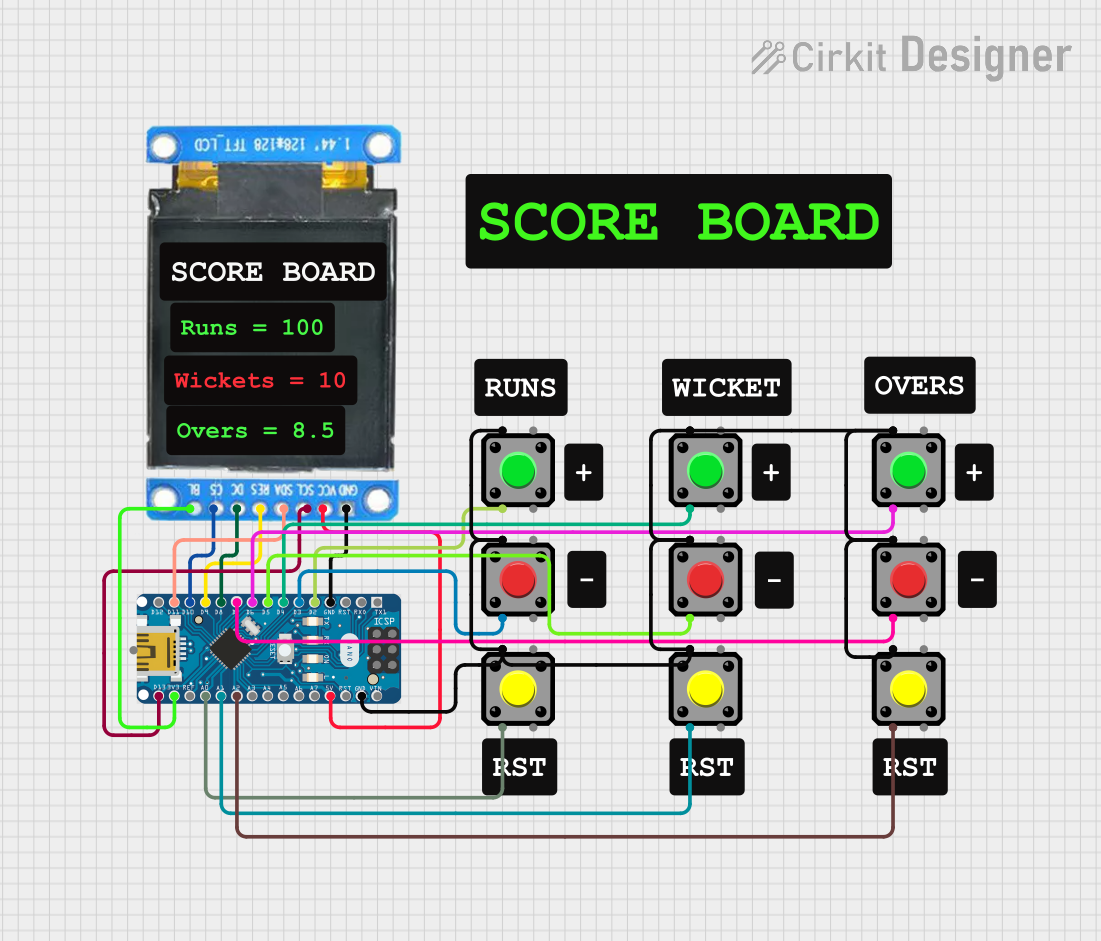
 Open Project in Cirkit Designer
Open Project in Cirkit Designer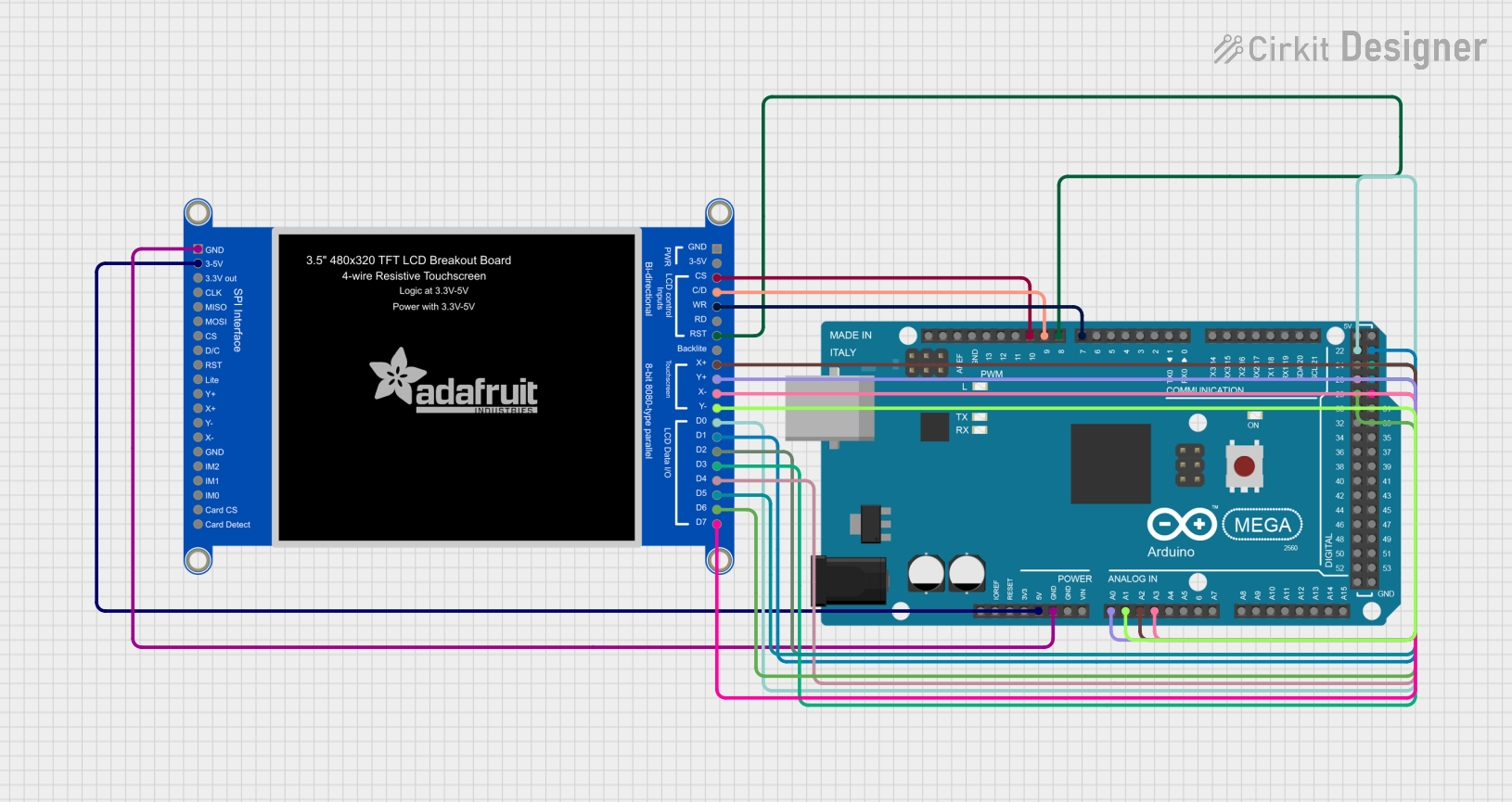
 Open Project in Cirkit Designer
Open Project in Cirkit Designer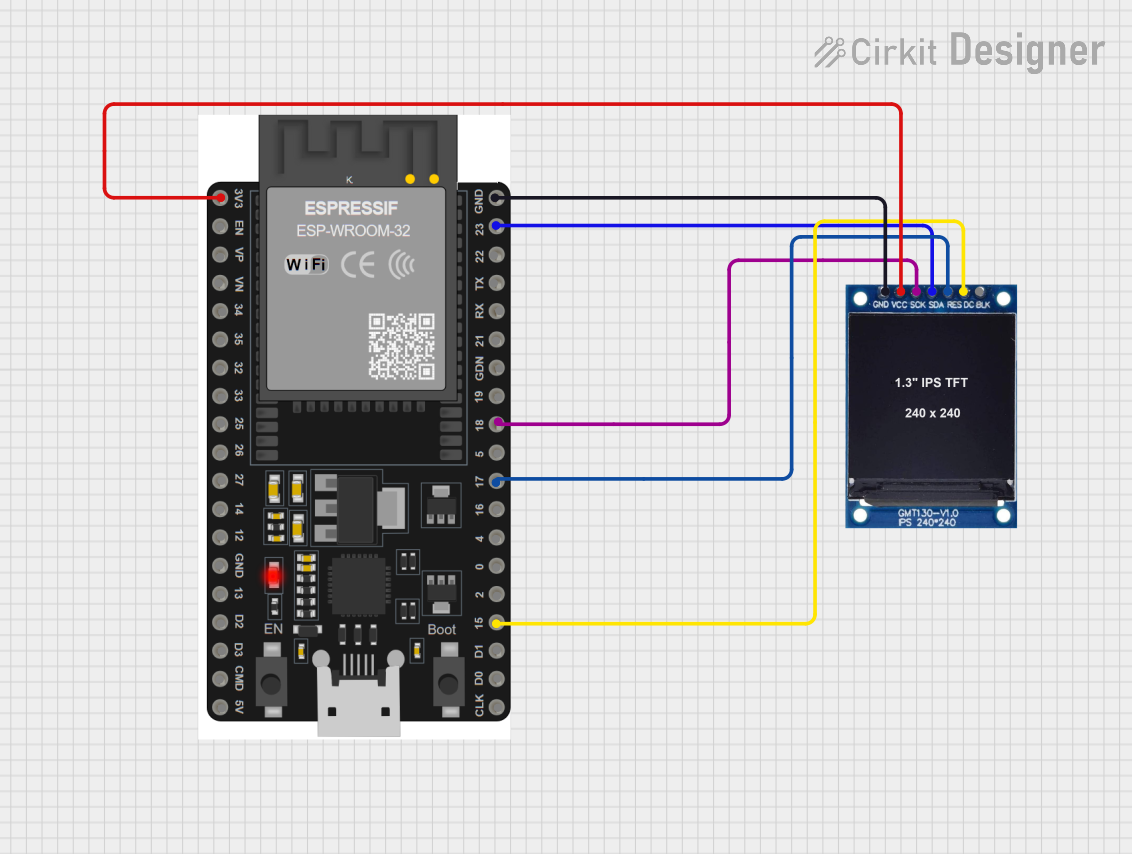
 Open Project in Cirkit Designer
Open Project in Cirkit Designer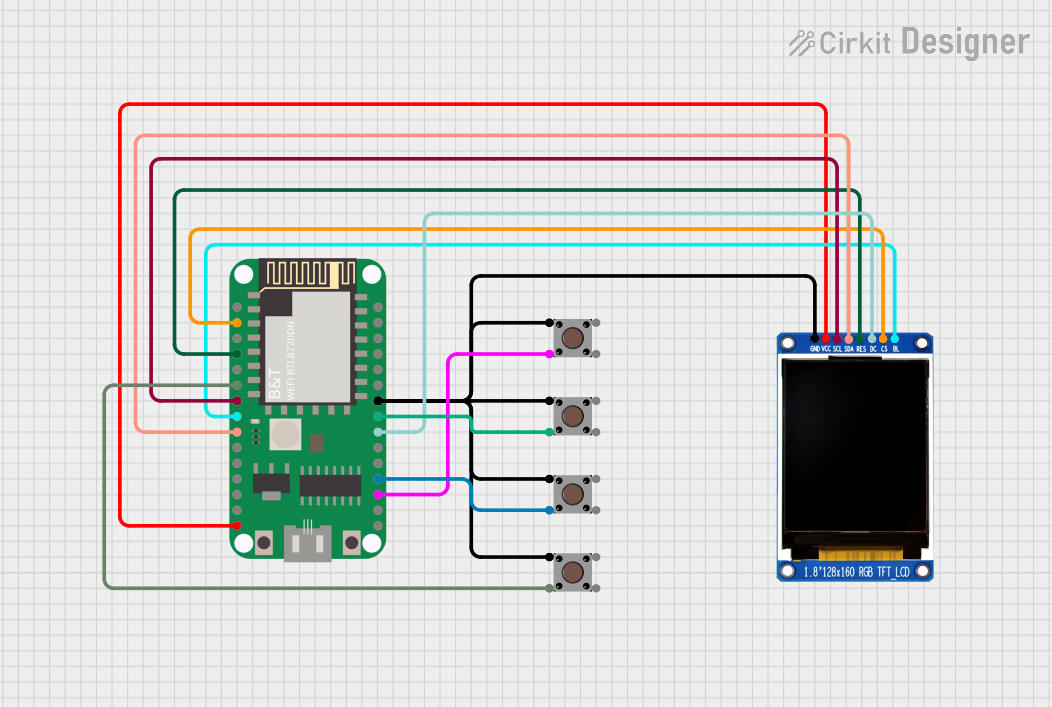
 Open Project in Cirkit Designer
Open Project in Cirkit DesignerExplore Projects Built with 1.8" 128x160 TFT 65K color screen

 Open Project in Cirkit Designer
Open Project in Cirkit Designer
 Open Project in Cirkit Designer
Open Project in Cirkit Designer
 Open Project in Cirkit Designer
Open Project in Cirkit Designer
 Open Project in Cirkit Designer
Open Project in Cirkit Designer